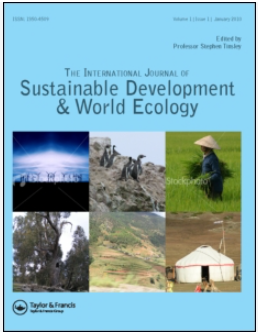Expanding protected areas in a Neotropical hotspot
IF 7.7
3区 环境科学与生态学
Q1 ECOLOGY
International Journal of Sustainable Development and World Ecology
Pub Date : 2023-01-03
DOI:10.1080/13504509.2022.2163717
引用次数: 0
Abstract
ABSTRACT The region of central Veracruz is considered a biodiversity hotspot due to its high species richness and environmental heterogeneity, but only 2% of this region is currently protected. This study aimed to assess the current protected area system’s effectiveness and to identify priority conservation areas for expanding the existing protected area system. We used the distribution models of 1186 species from three kingdoms (Animalia, Plantae, and Fungi) together with ZONATION software, a conservation planning tool, to determine areas that could help expand the current network of protected areas. We applied three different parametrizations (including only species, using the boundary quality penalty, and using corridor connectivity). We found that protecting an additional 15% of the area would increase, between 16.2% and 19.3%, the protection of the distribution area of all species. We propose that the regions with a consensus of the three parametrizations should be declared as new protected areas to expand 374 km2 to the 216 km2 already protected. Doing so would double the protected surface in central Veracruz. The priority areas identified in this study have more species richness, carbon stock values, natural vegetation cover, and less human impact index than the existing protected areas. If our identified priority areas are declared protected, we could expect a future recovery of endangered species populations for Veracruz. The proposed new protected areas are planned and designed as corridors connecting currently isolated protected areas to promote biodiversity protection.在新热带热点地区扩大保护区
由于物种丰富度和环境异质性高,韦拉克鲁斯中部地区被认为是生物多样性的热点地区,但目前该地区只有2%的地区受到保护。本研究旨在评估现有保护区系统的有效性,并确定扩大现有保护区系统的优先保护区。利用动物、植物和真菌三界1186个物种的分布模型,结合保护规划工具ZONATION软件,确定了有助于扩大现有保护区网络的区域。我们应用了三种不同的参数化(仅包括物种、使用边界质量惩罚和使用走廊连通性)。研究发现,每增加15%的保护面积,所有物种分布面积的保护面积将增加16.2% ~ 19.3%。我们建议将三个参数一致的区域划为新保护区,在现有保护区216平方公里的基础上再扩大374平方公里。这样做将使韦拉克鲁斯中部受保护的面积增加一倍。与现有保护区相比,优选区物种丰富度、碳储量、自然植被覆盖度较高,人类活动影响指数较低。如果我们确定的优先区域被宣布为受保护区域,我们可以预期未来韦拉克鲁斯的濒危物种数量会恢复。拟议的新保护区被规划和设计为连接目前孤立的保护区的走廊,以促进生物多样性的保护。
本文章由计算机程序翻译,如有差异,请以英文原文为准。
求助全文
约1分钟内获得全文
求助全文
来源期刊
CiteScore
11.10
自引率
3.60%
发文量
58
审稿时长
18-36 weeks
期刊介绍:
The International Journal of Sustainable Development and World Ecology is now over fifteen years old and has proved to be an exciting forum for understanding and advancing our knowledge and implementation of sustainable development.
Sustainable development is now of primary importance as the key to future use and management of finite world resources. It recognises the need for development opportunities while maintaining a balance between these and the environment. As stated by the UN Bruntland Commission in 1987, sustainable development should "meet the needs of the present generation without compromising the ability of future generations to meet their own needs."

 求助内容:
求助内容: 应助结果提醒方式:
应助结果提醒方式:


